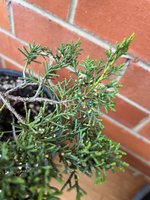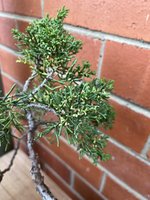These seem to be female flowers, they have a square-like shape with notches on the top. If they aren't fertilized, they go from off-white to yellow in a week or two and will drop off. The ends they leave, will not produce new growth that year but they can bud back a little further down.
Male pollen cones tend to be ribbed and more rounded, like striped pinheads, they do not have notches and they open up after a couple weeks or sometimes even months. Once open, they are softer and can easily be crushed with very little force. Female flowers more or less keep their shape and do not easily fall apart (but they do drop off very easy, way easier than male cones). Most junipers are either male or female, and you'd need both to produce viable seeds. Some exceptions exist, but self fertilization in junipers is a rare occurrence because the flowers tend to be a couple weeks apart if they are on the same plant. Wild junipers like procumbens and chinensis (both native to Japan) don't hybridize because they flower at different times. Phoenicea varieties can be identified by their flowering period with var. turbinata being later in the year than var. phoenicea.
Most junipers flower once a year, but I've seen it happen more often in chinensis and sabina; in the dead of winter and in the spring or fall. I mean they flower twice, because it seems to be that they produce separate flushes that finish entirely (and either drop structures or produce berries) and then push out another flush that comes full circle. This is probably why they are so easily hybridized, it happens naturally sometimes.
Pretty problematic for the people who are allergic to juniper pollen, because in a sense, there is no time of year that common garden varieties aren't flowering.
People prefer the females because they don't produce pollen and because their flowering structures come off more easily and require way less maintenance than male plants.



